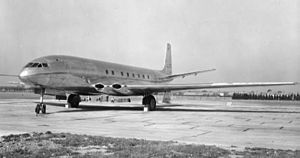Jet Age
This article needs additional citations for verification. (September 2014) |

| History of technology |
|---|
The Jet Age is a period in the
In addition to pure jet engines, turbine-driven propeller engines delivered a smoother ride and better
The introduction of the
Origins
The term "Jet Age" was coined in the late 1940s.[1] At the time, the only jet-powered aircraft in production were military types, most of which were fighters. The expression reflects the recognition that the jet engine had effected, or would soon, a profound change in aeronautics and aviation.
One view is that the jet age began with the invention of the jet engine in the 1930s and 1940s.[2] In the history of military aviation it began in 1944 with the introduction into service of the Arado Ar 234 reconnaissance bomber and the Messerschmitt Me 262 fighter during World War II.[3][4] In commercial aviation, the jet age was introduced to Britain in 1952 with the first scheduled flight of the de Havilland Comet airliner and to America later in the decade with the first American-built jet airliners.[5][6]
Civil aviation
The British de Havilland Comet was the first jet airliner to fly (1949), the first in service (1952), and the first to offer a regular transatlantic service (1958). One hundred and fourteen of all versions were built. However, the first jet airliner to provide a sustained and dependable service was the Soviet Tupolev Tu-104 (201 built) which was the only jet airliner in operation worldwide between 1956 and 1958 (the Comet having been withdrawn in 1954 due to structural failure issues). The Comet and Tu-104 were later outstripped in production by the United States' Boeing 707 (which entered service in 1958) and Douglas DC-8, which joined it in the skies over the next few years. Other types of the period included the French Sud Aviation Caravelle. After the 707 began service on the New York to Paris route on October 26, 1958, with Pan American, 1959 became the first year that more transatlantic passengers traveled by air than by sea.[citation needed]
As the number of passengers soared, it became impractical to increase the number of aircraft flying from the major hub airports. International airports like that of Orly Airport in Paris, France would construct terminals around bag-check and customs processing efficiency in response to rising passenger numbers.[7] Instead, designers created even larger widebody airliners and the engine manufacturers responded with larger, more powerful and also more fuel-efficient engines. The first "jumbo jet" was the Boeing 747, and it both increased airport passenger capacity and reduced the cost of air travel, further accelerating the social changes brought about by the Jet Age.[citation needed]
Military aviation
Military aviation had entered the jet age somewhat earlier, during the closing stages of World War II. In the early postwar years, the increasing use of jet aircraft had little significant impact, serving mainly to continue the slow but steady improvements in performance seen in the past. Supersonic flight brought about a step change in aircraft performance. The
See also
References
- ^ "The Story goes on" (PDF). Retrieved January 25, 2020.
- Encyclopedia Britannica. Retrieved 2020-01-26.
- Encyclopedia Britannica. Retrieved 2020-01-26.
- ^ Green, W.; "Warplanes of the Third Reich", Macdonald and Jane's (1970).
- Flight Global. Archived from the originalon February 1, 2014.
- ^ "The Jet Age, 1958 – today," America by air, Smithsonian national Air and Space Museum.[1]
- ISSN 1537-6370.
